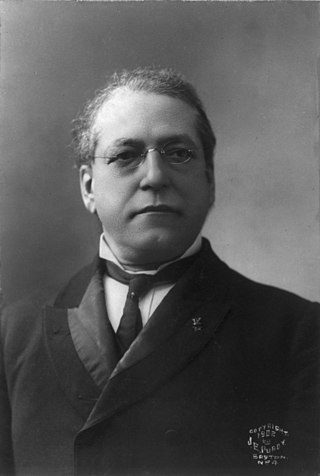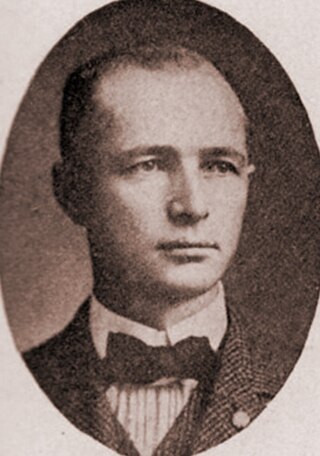Related Research Articles

Samuel Gompers was a British-born American cigar maker, labor union leader and a key figure in American labor history. Gompers founded the American Federation of Labor (AFL) and served as the organization's president from 1886 to 1894, and from 1895 until his death in 1924. He promoted harmony among the different craft unions that comprised the AFL, trying to minimize jurisdictional battles. He promoted thorough organization and collective bargaining in order to secure shorter hours and higher wages, which he considered the essential first steps to emancipating labor.

The American Federation of Labor was a national federation of labor unions in the United States that continues today as the AFL-CIO. It was founded in Columbus, Ohio, in 1886 by an alliance of craft unions eager to provide mutual support and disappointed in the Knights of Labor. Samuel Gompers was elected the full-time president at its founding convention and was re-elected every year except one until his death in 1924. He became the major spokesperson for the union movement.
Craft unionism refers to a model of trade unionism in which workers are organised based on the particular craft or trade in which they work. It contrasts with industrial unionism, in which all workers in the same industry are organized into the same union, regardless of differences in skill.

The Amalgamated Clothing and Textile Workers Union (ACTWU) was a labor union representing workers in two related industries in the United States.

The Trade Union Educational League (TUEL) was established by William Z. Foster in 1920 as a means of uniting radicals within various trade unions for a common plan of action. The group was subsidized by the Communist International via the Workers (Communist) Party of America from 1922. The organization did not collect membership dues but instead ostensibly sought to both fund itself and to spread its ideas through the sale of pamphlets and circulation of a monthly magazine.
The International Typographical Union (ITU) was a North American trade union for the printing trade of newspapers and other media. It was founded on May 3, 1852, in the United States as the National Typographical Union. It changed its name to the International Typographical Union at its Albany, New York, convention in 1869 after it began organizing members in Canada. The ITU was one of the first unions to admit female members, admitting women members such as Augusta Lewis, Mary Moore and Eva Howard in 1869.

James Paul Maher was an American labor union official, businessman, and politician. A Democrat, he is most notable for his service as a U.S. Representative from New York, a position he held for five terms from 1911 to 1921.

Maximillian Sebastian Hayes was an American newspaper editor, trade union activist, and socialist politician. In 1912 Hayes became the first candidate to challenge Samuel Gompers for the presidency of the American Federation of Labor in nearly a decade, drawing about 30 percent of the vote in his losing effort. Hayes is best remembered as the long-time editor of the Cleveland Citizen and as the vice presidential candidate of the Farmer–Labor Party ticket in 1920.

Alex Rose was a labor leader in the United Hatters of North America (UHNA) and the United Hatters, Cap and Millinery Workers International Union (UHCMW), a co-founder of the American Labor Party, and vice-chairman of the Liberal Party of New York.
Benjamin "Ben" Schlesinger was a Lithuanian-born American trade union official and newspaper office manager. Schlesinger is best remembered as the nine-time president of the International Ladies Garment Workers Union (ILGWU), serving from 1903 to 1907, again from 1914 to 1923, and finally from 1928 until his death in 1932. He was also the managing editor of The Jewish Daily Forward from 1907 to 1912 and the resident manager of the Chicago edition of that publication beginning in 1923.
The United Hatters, Cap and Millinery Workers International Union (1934–1983), also known by acronyms including UHCMW, U.H.C. & M.W.I.U. and UHC & MWIU, was a 20th-century American labor union.

The United Hatters of North America (UHU) was a labor union representing hat makers, headquartered in the United States.
The Journeymen Tailors Union (JTU) was a trade union in the United States, with some local branches in Canada.
Max Zaritsky (1885–1959) was an American union leader of the United Hatters, Cap and Millinery Workers International Union (UHCMW) as well as co-founder of both the American Labor Party and Liberal Party of New York State.
The Italian Federation of Hat Workers was a trade union representing hatters in Italy.
The International Glove Workers' Union of America (IGWUA) was a labor union representing workers involved in making gloves in the United States and Canada.
The International Brotherhood of Pulp, Sulphite, and Paper Mill Workers (IBPSPMW) was a labor union representing workers involved in making paper in the United States and Canada.
The Metal Polishers', Buffers', Platers' and Allied Workers' International Union (MPBP) was a labor union representing metal workers in the United States and Canada.
The Laundry Workers' International Union (LWIU) was a labor union representing laundry workers in the United States.
Martin Lawlor was an Irish-born American labor union leader.
References
- 1 2 Reynolds, Lloyd G.; Killingsworth, Charles C. (1944). Trade Union Publications: The Official Journals, Convention Proceedings, and Constitutions of International Unions and Federations, 1850-1941. Baltimore: Johns Hopkins Press.
- ↑ Handbook of American Trade Unions (PDF). Washington DC: United States Department of Labor. 1926. Retrieved 24 April 2022.
- ↑ "MICROFILM SERIES 2: DESCRIPTION OF THE RECORDS". The Sam Gompers Papers. University of Maryland. Retrieved 24 April 2022.